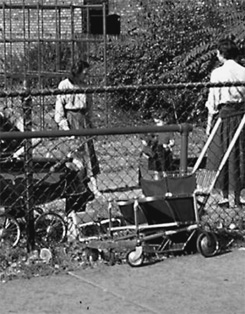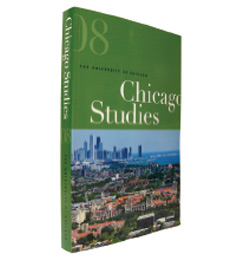The Secret History of Butternut Playlot
An excerpt from student research on Chicago’s neighborhoods
By Stephanie Dock, AB’06
In November 2008 the College launched a new academic journal, Chicago Studies, which showcases undergraduate papers on Chicago history. All four papers in the inaugural issue—chosen by managing editor David Spatz, AM’03, along with professors Kathleen Neils Conzen, Michael Conzen, and Adam Green—grew out of a class assignment from the course Chicago and the South Side, taught by Kathleen Neils Conzen. The assignment: take a walk around a small section of Hyde Park and find something interesting.
Stephanie Dock, AB’06, chose Woodlawn Avenue and 53rd Street. There she discovered a small playlot that she had never noticed on her daily bike rides to campus. “I kept thinking there must have been some building on it at some point,” she says. “After a lot of fruitless searches” of back issues of the Chicago Tribune and Hyde Park Herald, “I found the play yard contest and realized I was on to something.” Dock’s paper, “From Vacant Lot to Playlot: The Chicago Motor Club’s Play Yard Contest and the Provision of Public Space,” is condensed here. Dock is currently working on a master’s in city planning at the University of California, Berkeley.—Carrie Grolus, AB'91, AM'93
Venturing down Woodlawn Avenue near 53rd Street, one might happen to notice a small playground nestled between two apartment buildings: Butternut Playlot, a “Children’s Playlot for Boys and Girls Under 12 Years.”
In 1948 a group of parents got together to create the “Community Tot Lot,” a private playlot with membership open to all. The parents cleaned the site, set up equipment, and divvied up the duty of watching the children. By 1950, 80 children regularly used it. Annual membership rates were set: $1 for a family’s first child and 25 cents for each subsequent child in 1950, with badges given to each child to indicate they had paid. In 1958 the park was purchased by the city and transferred to the park district.
Although a seemingly isolated incident, across the nation thousands of play yards were being created. The existence of such spaces has been largely hidden from historians, much as they are tucked away from the general notice of passersby. Here in Chicago it is thanks to a contest run by the Chicago Motor Club that we can document their existence. In 1949 the Community Tot Lot was entered in a contest for the best private “play yards.” Between 1934 and 1958, the Motor Club held the contest, resulting in more than a hundred entrants over 17 years.
The Motor Club’s logic was simple: alarming numbers of children were being killed each year playing in the street: 164 in Cook County in 1933. The solution, as the Motor Club saw it, was to find them better, safer places to play. The private initiative behind the play yards was effectively filling a public need, anticipating a public policy shift in urban park ideology.
The Contest
The criteria were quite loose: the yard had to be private and in operation during summer. Size was not a major consideration, nor was a large outlay of funds. Children were encouraged to participate in the planning and construction, because if a yard did not attract children, it was not very useful.
The yards were generally of one of three types: backyards, vacant lots, and apartment backyard play areas. Most numerous were the backyards that parents created for their own children and expanded to serve their playmates.
Vacant lots were also quite prevalent. Not all were community initiatives—some were created by individuals who recognized a need in their neighborhood. In one case, a truck driver with no children on the West Side turned two lots into a yard that attracted some 600 children. Similarly, the Quayles, a childless couple, converted a vacant lot on the South Side in 1943. A racially integrated play yard for seven years, the site was purchased by the city, which began running it in 1950 as Quayle Playlot, much as it did with Butternut.
The Public Context: Public Parks and Space
This paucity of play spaces, admitted by recreation officials themselves, was the outcome of prior park traditions. In 1934, most of the park space in the city was in the large “pleasure grounds” of the late 19th and early 20th centuries.
In the period leading up to the contest, Progressive era reformers had introduced the playground movement. But the movement was “never successful enough to capture the imagination of the proponents of large-scale urban beautification,” more interested in projects like Chicago’s lakefront as outlined in Burnham’s 1909 Plan of Chicago.
The impetus towards backyard play came more successfully from child-care authorities concerned about the “decline of the family.” Backyard play areas kept children safe while maintaining family unity. Middle-class families in particular adopted this advice: Howard Chudacoff notes that “by the early 1930s, 46 percent of families of means had backyard swings and 58 percent had sandboxes.” Encouraging this trend was the fact that public parks were facing an image crisis, as a 1939 survey of park users indicated. In part due to the earlier period’s focus on neighborhood parks in working-class areas, upper-class children were not using the city’s parks.
The final dimension to the play yard contest is the issue of streets. Where streets had once been a shared public space for various endeavors, including play, Peter Baldwin argues that throughout the early 20th century there was an increasing appropriation of this space for traffic alone. Baldwin documents this change in Hartford, Connecticut, up to 1930. Tellingly, he notes that the Automobile Club of Hartford was “firmly opposed to street play, which made driving slower and more stressful. The club’s publications initially complained about children as annoying obstacles to traffic, but later spoke in terms of child welfare.”
The play yard contest came along at a moment when the use and control of the streets were shifting to automobiles, but before the park system had been able to provide public space in compensation. The community was left to deal with the resulting carnage from this park policy failure, creating the play yards in hopes of luring children to safety.

